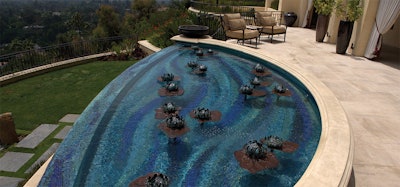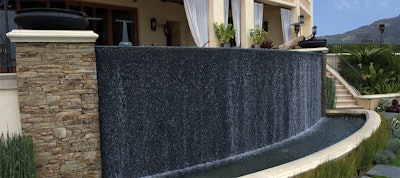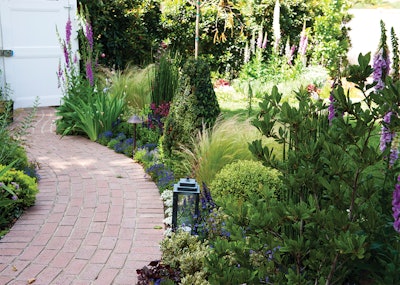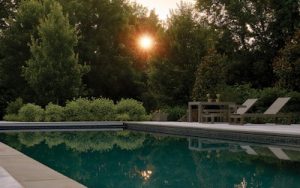Editor’s Note: This article was first published by WaterShapes.
A well-conceived softscape environment
undoubtedly connects with
one’s inner soul — perhaps
more than any design element apart
from water.
I prioritize plants largely because
they provide a comforting bridge to the
natural world, and they’re beautiful — or
at least they certainly can and should be.
Regardless of architectural style, plants
enable the designer to transport you to
a place of serenity, contemplation and
joy. Much like water, plantings connect
with our innermost spirit. Innately, we
just feel wonderful in the presence of
beautiful plant settings.
That’s why planting themes should
be at the forefront of any project
development.
Yet, so often the planting design
becomes a secondary design element
rather than an integral part of the
project. I always approach and consider
planting plans in the initial project
development stages, knowing that, later
on, those verdant and colorful spaces
will live on as they elevate the experience
of being there.
Architecture Specific
There are many ways to approach
planting design. You can research and learn how to commence with your
project, and there are endless resources
you can turn to. I start with the
architecture to establish a tight synergy
between plants and the architectural
theme.
Just as you want your hardscape
and watershapes to harmonize with
the home’s architecture, so too the
plants play a vital role in expressing the
design theme of the property. As is true
of hardscape and watershape, all the
design elements need to seamlessly flow
with each other to ultimately achieve that
“wow!” experience.
Specifically, knowing what types of
plants are used with a given architectural
style is the key. It’s not a hard and fast
set of rules, but there are definitely plant
selections that have traditionally been associated with different design styles,
modes and motifs.
I’ve spent years studying some of
the more prominent homes from each
era and their garden designs. I study the
philosophy of the design tradition, and
the percentages of certain types of plants
used in a given style, and how they
indigenously cohabitate.
As an example, here in Southern
California, I’ve worked on several
homes with Spanish Colonial, or more
accurately, Spanish Colonial Revival
architecture, which became extremely
popular in the late 1920s, resulting in
some of the most iconic properties in
the region.
In Spanish Colonial Revival, you’ll
find the widespread use of drought-tolerant
species, largely because the
region has a semi-arid climate and is
prone to drought. In those designs, I
turn to a variety of cacti species, along
with agave, aloe, lavender, bougainvillea,
lantana, sago palms, birds of paradise,
among many others. I might use
multiple types of plants in those
categories to add variety and interest,
but for the most part, I stay within the
boundaries of the property’s overall
design motif.
There are many familiar examples
of plants married to a particular
architectural style. If I’m working with a
Cape Cod home, I’ll turn to hydrangeas,
ornamental grasses, lavender, fescue and
others. For an English garden, I’ll use
box hedges, with delphinium, hollyhock
and geraniums. In a contemporary
setting, I’ll select plants with sculptural
forms, cacti, succulents, yucca and
agapanthus and, perhaps my favorite of
all plant types, bromeliads.
Working with designs that are rooted
in history, you have the ability to create
timeless gardens — a quality that can
inspire the human imagination by
connecting nature and history.
 Plantings, combined with watershapes, can take on any number of stylistic motifs, but in any setting, they are truly natural companions.
Plantings, combined with watershapes, can take on any number of stylistic motifs, but in any setting, they are truly natural companions.
Considering Color
Color is the next thing I consider. To my
eyes, there’s nothing more beautiful
than the colors of nature. For all of
humankind’s vast ingenuity, we will
never be able to replicate the remarkable
qualities of plant colors. That’s why
plantings are far and away the best way
to add color to the design.
I group plant types by the colors
they produce. I have a folder for blues,
lavender, whites, red, orange and pink,
and the lists are constantly growing. And
it’s not just for flowering plants. While
the colors of blossoms provide dramatic
highlights and points of interest within
the garden, the green palette plays
a structural visual role and is just as
important as the flowers.
I categorize plants by their variations
of green. I call them salad greens, gray
greens, blue greens, yellow greens and
endless variations. I always create subtle
layers of different shades of greenery.
Designing with color does mean you
need to understand how to use a color
wheel, so you can work effectively with
contrasting and complimentary colors,
which is an entire design discipline unto
itself.
At that point, I’ll extract the plants in
the desired color hue categories, which
also relate to the specific architectural
motif. Once achieved, I am very close to
choosing my final palette of plants and
trees.


Nature Inspired
One of the interesting challenges
you face comes when working on a
property that does not have a distinct
architectural style, which we see much
of the time in housing developments.
In those situations, I turn to the
natural landscape for direction. If
you’re in the desert, you will lean on
cacti, succulents and palms that thrive
in arid environments. If you’re in a
wooded region, the choices might be
evergreens, ferns, rhododendron and
other denizens of the forest.
Considering the natural flora also
leads to plant selections that thrive in
a given climate zone. Not only does
that help harmonize gardens with their
natural surroundings, it makes taking
care of the plantings much easier
when they are naturally at home in a
given climate. If, for example, you try
to force lush tropical plantings into a
dry climate, you might be setting the
client up for high water bills and years
of frustration trying to keep the plants
looking hearty, and they can be highly
inappropriate from a design aspect.
Another major, nature-inspired
factor is the way that plants are grouped
together. Many times, designers will
place different types of individual plants
next to others, presumably to create
visual variety. I believe that’s a mistake.
In nature, plants drop seeds and grow
in large masses of groups. You rarely
see individual ferns or agaves growing
by themselves, but instead, they exist in
large stands.
Massing plant families in an area
sets off a timeless natural beauty! It
also allows the visual characteristics
of a given type of plant to make a
more cohesive statement than if they
are standing alone amongst other
unrelated species. With large stands
of plants, I’m able to create greater
contrast and establish visual rhythms
throughout the garden.
 Spanish Colonial architecture comes with a truly iconic planting palette, on full display here in the front yard of this stunning home in Southern California.
Spanish Colonial architecture comes with a truly iconic planting palette, on full display here in the front yard of this stunning home in Southern California.
Views and Transitions
In certain projects, I follow a common
principle of landscape design in which
you may place more structured planting
areas near the home. Those tend to
be more intimate spaces adjacent to decks, outdoor dining areas, pathways
and the house itself.
As you transition away from the
house, the plantings become more
natural, often providing a backdrop of
greenery and areas that transition to
vistas and the surrounding landscape.
The transition can be used to create
layered views that draw the eye into
the distance, and you can organize
pathways that lead you physically from
the gardens near the home to the
wilder parts of the property.
Considering physical movement
can be a powerful factor, meaning
that sense of taking a journey through
the landscape, I’m a proponent of
organizing the space so you don’t see
everything at once. As you walk from
place to place, you discover something
you hadn’t seen just a few steps before.
Perhaps you come upon a vignette of
roses, a stand of fruit trees, or a hidden
fountain, or aromatic plants, such as
gardenias or sweet-smelling jasmines.
Perhaps you’ll encounter the incredible
scent of lilacs.
Even for someone who lives there
and sees the garden every day, that
sense of discovery persists and can
create tremendous satisfaction,
whether you directly realize it or not.
As you move through the space and
encounter stands of different plants,
you gain a sense of discovery and
appreciate the variety within the
garden.
Plants, particularly tall ones like
trees or vertical shrubs such as
junipers, can be used to conceal
unwanted views of surrounding
buildings or roads. And they can be
used for other practical reasons such
as buffering wind and unwanted noise.
You might even be tempted to cut
bouquets and use the garden space to
add beauty indoors.
With so many intriguing
possibilities, it only makes sense to
consider plants and the role they will
play from the inception of the project.
 Layering color and texture creates both a sense of variety and interest. It’s like painting with nature.
Layering color and texture creates both a sense of variety and interest. It’s like painting with nature.
Client Input
Lastly, we must listen carefully to
input from our clients to ensure their
expectations have been met. Some
will have very specific ideas and
preferences, others far less so. They
may point out plants they’ve always
loved or those that stand out because
of an experience they had on vacation.
And, as aforementioned, we always
need to consider how they plan on
using their garden spaces, a factor that
touches all aspects of exterior design.
Some homeowners are more
concerned with low maintenance
or environmental sustainability.
Some may want to attract birds and
butterflies, while others love fragrant
plants, or even edibles they can use
in the kitchen. Many clients simply
want a tranquil setting where they can
connect with nature and ease their
stress and anxiety.
When you have a broad
understanding and familiarity with the
plant kingdom and how to use it as a
design element, you are able to bring
a spectrum of options and ideas for
client discussions and the resulting
design process.
The possibilities are limitless and
the resulting enjoyment you add to the
lives of others will be as enduring as
the seasons themselves.
Everyone deserves to have a
beautiful garden environment.
Mark David Levine is a landscape designer based
in Westlake Village, Calif. He has been designing
upscale residential landscapes for 40 years. His
work features extensive garden areas across a
broad range of styles, captivating and enhancing
beautiful watershapes of all architectural themes.



